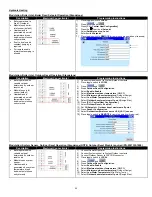
27
For outdoor installations in colder climates a snow screen should be installed to prevent snow and ice accumulation on and around the
appliance. Regular inspections should be made to ensure that air intake and vent are free of snow and ice. Always consider the use of a
shelter such as a garden shed in lieu of direct exposure of the appliance to the elements. The additional protection afforded by the shelter
will help to minimize nuisance problems with electrical connections and will allow easier servicing of the appliance under severe weather
conditions.
4.2
WARNING REGARDING CHILLED WATER AND HEATING COIL SYSTEMS
When an appliance is connected to a refrigeration system where the same water is used for heating and cooling, the chiller must be piped
in parallel with the appliance. Appropriate flow control valves; manual or motorized must be provided to prevent the chilled water from
entering the appliance.
The appliance piping system of a hot water boiler connected to heating coils located in air handling units where they may be exposed to
refrigerated air circulation must be equipped with flow control valves or other automatic means to prevent gravity circulation of the boiler
water during the cooling cycle.
Figure 18: Chilled Water System
4.3
INLET AND OUTLET CONNECTIONS
All water connections are groove-lock fittings.
For ease of service, install unions on inlet and outlet of the appliance. The connection to the appliance marked “Inlet” on the
header should be used for return from the system. The connection on the header marked “Outlet” is to be connected to the
supply side of the system.
4.4
MINIMUM PIPE SIZE REQUIREMENTS
The equivalent number of straight feet of pipe for each valve and fitting in the connecting piping must be considered to properly arrive at
the total equivalent feet of straight pipe in the field installed piping to the appliance. See the piping requirements in Part 11 - Installation
section of this manual. Consult factory if longer piping distances are required for a specific application.
4.5
HEAT EXCHANGER
The heat exchanger is of fully welded construction, and is cylindrical in appearance. The heat exchanger is a vertical, two-pass, counter-
flow, fire-tube design and consists of an integral combustion chamber with an inner tube bundle for primary heat transfer and an outer
tube bundle to extract latent heat from flue gases. This heat exchanger is designed to withstand 160 PSIG working pressure.
A factory recommended circulating pump ensures proper water flow during burner operation so as not to exceed maximum recommended
temperature rise. Scale formation in the heat exchanger is controlled by proper water treatment.
4.6
LOW WATER TEMPERATURE SYSTEMS
In applications where the heating system requires supply water temperatures below 110°F, connections may be made directly to the
Advantus
. At incoming temperatures of 120°F or lower the
Advantus
achieves maximum efficiency. Inlet temperatures must not drop
below 40°F to prevent freezing.
Return
Supply
System
Pump
Summary of Contents for ADVANTUS AVH 500
Page 2: ......
Page 3: ......
Page 38: ...31 Figure 23 Recommended Piping with Reverse Return and Variable Primary Flow...
Page 88: ...81 PART 12 EXPLODED VIEW Figure A...
Page 89: ...82 Figure B FAN BURNER ASSEMBLY AV500 600 some items may not be as shown...
Page 90: ...83 Figure C FAN BURNER ASSEMBLY AV800 4000 some items may not be as shown...
Page 91: ...84 Figure D Figure E...
Page 92: ...85 Figure F Figure G...
Page 93: ...86 Figure H CONTROL BOARD ASSEMBLY...
Page 100: ...93 PART 13 ELECTRICAL DIAGRAMS...
Page 101: ...94...
Page 102: ...95...
















































